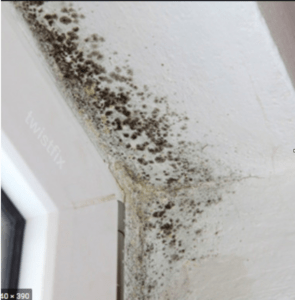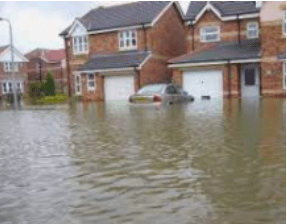Unfortunately, damp is a familiar problem for many tenants in the U.K. When faced with damp in your rented accommodation, it can be not only unpleasant, but damaging to your health and even render your home uninhabitable. It’s vital to inform yourself of your rights as a tenant as well as whether you have a case against your landlord. Though you will often hear people say “you can claim against your landlord for damp and mould,” in actual fact, it’s not always such a straightforward issue. This article introduces the key information you need to understand damp and disrepair claims, what your rights are, and what you can do about it.
Different types of damp
First, it’s necessary to identify what kind of damp you’re dealing with. There are different types of damp which can include:
- Condensation dampness.
- Penetrating dampness.
- Rising damp.
- Traumatic damp
It is not enough to prove that you simply have damp to succeed in a claim against your landlord. The cause of the damp needs to be identified.
Causes of damp
- Causes of condensation damp can be for example, too much vapour, inadequate insulation, insufficient heat, or lack of ventilation.

Photo caption: Mould caused by condensation damp.
2. Causes of penetrating damp can be for example, damaged roof tiles, cracks in the walls, faulty guttering, or internal damage from leaking or burst pipes.

Photo caption: Deterioration of paint and plaster due to penetrating damp.
3. The cause of rising damp is moisture from the ground travelling up through the walls. A cause of rising damp can be a missing or faulty damp proof course.

Photo caption: Damp signs above the skirting board can be a sign of rising damp.
4. An unexpected flood can cause traumatic damp.

Reasons tenants can claim disrepair
You may be able to claim for disrepair under your tenancy agreement, the Landlord and Tenant Act 1985, the Defective Premises Act 1972, and the Housing Act 2004 amongst others.
Damp is a complicated area – some examples of why are:
- If there has been damage to your property because of damp then it is likely to be classed as disrepair, for example the internal plasterwork has been damaged. However, if there is no damage to your property, it may not be disrepair.
- The absence of a damp-proof course can be claimed as a design/construction defect and is not disrepair. Whereas a damaged or breached damp proof course is disrepair.
How to inform your landlord of disrepair
Your landlord is responsible for most of the repairs in your property. Once notified, they must complete them within a reasonable time frame. However, a “reasonable time” does depend on the gravity of the problem. If the problem is not so serious, a “reasonable time” will be decided on a case-by-case basis.
It’s not unusual for tenants to get tired of contacting their landlord regarding disrepair if nothing ever results from their correspondence. Though this is understandable, it is imperative that you inform your landlord properly of the disrepair to have a good chance of forcing them to carry out the appropriate repairs whether by negotiations or through the courts. If your case goes to court, you need to prove to a judge that your landlord is fully aware of the disrepair and that they have not fulfilled their repairing obligations.
It is advisable to correspond with your landlord using a ‘recordable method’. Ensure to keep records of any online maintenance forms that you fill out as well as any direct correspondence. If you speak on the phone, ensure to follow up with an email. It is important not to rely on your landlord’s records as they may not be up to date.
Remember, the amount of evidence that you have showing that you reported the disrepair may impact the amount of compensation you are able to secure.
What happens if your damp is not disrepair?
If damp is not classed as disrepair, it does not mean that you cannot make a claim against your landlord. If it is unreasonable for you to live in your property because the damp seriously affects your health, puts you at risk of physical injury or you cannot make full use of your home, then you may still have a claim.
Just because your landlord states the damp is the result of a design/construction defect, it does not mean that they can automatically escape liability, they may still have an obligation to ensure the property is fit for habitation.
If you would like to speak directly to a housing solicitor without having to go through a third party first, then get in touch with us here at 360 Law services to speak with one of our expert lawyers.
* Disclaimer: The information is for general information only. It does not constitute legal advice and should not be treated as such. It is provided without any representations or warranties, express or implied. *
FAQs about Damp and Disrepair
Who is liable for damp?
As we’ve seen, in many instances it is your landlord who is liable for damp. However, it is not always clear cut and since damp is a complex legal subject and it is advisable to speak with a solicitor to understand your position and the strength of your case.
You should notify your landlord of all disrepair. If you don’t, you will not be able to claim for disrepair.
How much compensation can I get?
There are no rules or formula for calculating compensation, consideration is given to previous case law. If your solicitor is experienced, they will know through their knowledge the likely compensation that may be awarded.
A very simple brief explanation of how compensation for inconvenience is calculated:
How long you have lived in the property with the disrepair x £ rent per month = how much you have been inconvenienced.
Can I refuse to pay rent if there is mould UK?
You do not have the right to withhold your rent because your landlord has failed to carry out the repairs that you have reported.
It is very risky to withhold your rent because your landlord may start possession proceedings against you. You may have a defence to such proceedings by way of a set-off the disrepair, but it is likely that the rent owed will still be higher than the compensation you will receive, which means you could be evicted.
There is a common law right for you to use your rent money to carry out the repairs. You must be very certain that your landlord is legally liable for the disrepair. This route is very limited, and you must follow a specific and very strict procedure. In addition, you will be responsible for the quality of the work carried out.
It is not advisable to withhold your rent. Please seek specialist advice in relation to withholding your rent or using your rent to carry out repairs.
If you think you have a disrepair claim, please do not hesitate to contact us to discuss this further.



